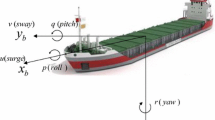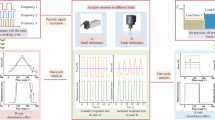Abstract
Electromagnetic linear actuators are widely used as drives in gas regulating valve, which is the key factor to determine the performance of the gas valve. In order to improve the performance of Electromagnetic direct-drive gas valve (EMDGV), a compound controller for non-repetitive point-to-point motions was proposed in this paper, combining with the advantages of Active disturbance rejection control (ADRC), Time-optimal control (TOC) and Sliding mode control (SMC). Simulation and experimental results show that the proposed method has the characteristics of fast response and high precision, and can achieve soft landing control. The response time is less than 8 ms, the control accuracy is 0.02 mm, and the seating velocity is within 0.04 m/s. The proposed method also has strong robustness to actuator parameter variation and good anti-disturbance ability.
Similar content being viewed by others
Reference
S. Chang and L. Liu, A moving coil permanent magnet linear actuator with high power density, China Patent, CN101127474B (2010).
A. Şumnu, İ. H. Güzelbey and M. V. Çakir, Simulation and PID control of a Stewart platform with linear motor, Journal of Mechanical Science & Technology, 31 (1) (2017) 345–356.
L. W. Lee and I. H. Li, Design and implementation of a robust FNN-based adaptive sliding-mode controller for pneumatic actuator systems, Journal of Mechanical Science & Technology, 30 (1) (2016) 381–396.
A. F. Jahromi, W. F. Xie and R. B. Bhat, Robust control of nonlinear integrated ride and handling model using magnetorheological damper and differential braking system, Journal of Mechanical Science & Technology, 30 (7) (2016) 2917–2931.
J. Han, From PID to active disturbance rejection control, IEEE Transactions on Industrial Electronics, 56 (3) (2009) 900–906.
M. Li et al., Active disturbance rejection control for fractional-order system, ISA Transactions, 52 (3) (2013) 365–374.
Y.-Q. Xia et al., Recent developments in sliding mode control and active disturbance rejection control, Control Theory & Applications, 30 (2) (2013) 137–147.
Z. Zhu et al., Attitude tracking of rigid spacecraft based on extended state observer, 3rd International Symposium on Systems and Control in Aeronautics and Astronautics (2010).
X. Shi and S. Chang, Precision motion control of a novel electromagnetic linear actuator based on a modified active disturbance rejection controller, Proceedings of the Institution of Mechanical Engineers, Part I: Journal of Systems and Control Engineering, 226 (5) (2012) 606–614.
F. Yang et al., ADRC based study on the anti-braking system of electric vehicles with regenerative braking, 8th World Congress on Intelligent Control and Automation (2010).
C.-E. Huang, D. Li and Y. Xue, Active disturbance rejection control for the ALSTOM gasifier benchmark problem, Control Engineering Practice, 21 (4) (2013) 556–564.
B.-Z. Guo and F.-F. Jin, The active disturbance rejection and sliding mode control approach to the stabilization of the Euler–Bernoulli beam equation with boundary input disturbance, Automatica, 49 (9) (2013) 2911–2918.
Y. Xia and M. Fu, Compound control methodology for flight vehicles, Berlin: Springer, 438 (2013).
D. We, H. Xiong and J. Fu, Aircraft autopilot pitch control based on fuzzy active disturbance rejection control, International Conference on Industrial Informatics-Computing Technology, Intelligent Technology, Industrial Information Integration, IEEE (2015).
Q. Zheng, J. Tatsumi and Z. Gao, On combining active disturbance rejection with adaptive inverse control for fast tracking at low bandwidth, 33rd Chinese Control Conference (2014).
L. Liu and S. Chang, Motion control of an electromagnetic valve actuator based on the inverse system method, Proceedings of the Institution of Mechanical Engineers, Part D: Journal of Automobile Engineering, 226 (1) (2012) 85–93.
C. Tan, S. Chang and L. Liu, Dynamic performance design and analysis of hybrid excited linear actuator for on-off valve, International Journal of Applied Electromagnetics and Mechanics, 54 (2) (2017) 199–209.
B.-Z. Guo and Z. Zhao, On the convergence of an extended state observer for nonlinear systems with uncertainty, Systems & Control Letters, 60 (6) (2011) 420–430.
A. M. Tusset et al., Chaos control and sensitivity analysis of a double pendulum arm excited by an RLC circuit based nonlinear shaker, Journal of Vibration and Control, 22 (17) (2016) 3621–3637.
N. J. Peruzzi et al., The dynamic behavior of a parametrically excited time-periodic MEMS taking into account parametric errors, Journal of Vibration and Control, 22 (20) (2016) 4101–4110.
Author information
Authors and Affiliations
Corresponding author
Additional information
Recommended by Associate Editor Daeil Kwon
Jiayu Lu received a B.E. in Vehicle engineering from Nanjing University of Science and Technology, Nanjing, China. Now he is a Ph.D. candidate in Mechanical Engineering from Nanjing University of Science and Technology, Nanjing, China. And he is mainly engaged in the research of modelling, analysis and control of automotive mechatronic systems.
Siqin Chang is the Professor in the Department of Mechanical Engineering, Nanjing University of Science and Technology. He obtained a Ph.D. in Vehicle Engineering from Huazhong University of Science, Wuhan, China. In the recent ten years, he has worked in the areas of electronic vehicle control system, mechatronics technology and automobile power system.
Rights and permissions
About this article
Cite this article
Lu, J., Chang, S., Liu, L. et al. Point-to-point motions control of an electromagnetic direct-drive gas valve. J Mech Sci Technol 32, 363–371 (2018). https://doi.org/10.1007/s12206-017-1236-4
Received:
Revised:
Accepted:
Published:
Issue Date:
DOI: https://doi.org/10.1007/s12206-017-1236-4




